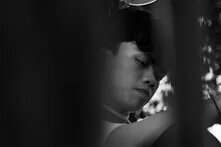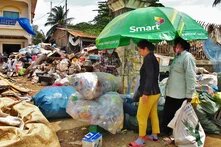The fear of getting darker skin and the desire for having lighter skin is common among the Cambodian society. Having lighter skin is part of Cambodia’s ideal of beauty and has shaped the Cambodian culture throughout. Cambodian kids are being told to protect their skin from sun exposure in order to get lighter skin or maintain theirs. Bunn Rachana, a Cambodian feminist and human rights advocate, made some hurtful experiences when she was younger. “I had much darker skin when I was young because I liked to wear shorts and sleeveless shirts. Sometimes my cousins laughed at me because I had darker skin.” At school, school mates teased her and compared her to a buffalo due to her skin color. “When I was a teenage girl, I suffered a lot emotionally in terms of trying to meet this beauty standard.”
But how did this ideal of beauty develop? Why do many Cambodians prefer lighter skin over darker skin?
In a nutshell, three factors can be differentiated in order to explain the social construction of skin privilege in Cambodia over time. First, early color preferences in most Asian societies are rooted in social hierarchies of classism and aesthetics prior to any Western contact. Even before colonialization, sun exposure was associated with status. It was assumed that low-income and low-status individuals such as manual workers or farmers were laboring outdoor exposed to the sun, whereas high-status people were working indoors. Lightness was associated with superiority, prosperity and intellectuality. On the opposite, a darker skin tone was linked to ugliness, poorness and inferiority. Second, European colonization exacerbated these assumptions. Many countries which have a colonial history, such as Cambodia, are influenced by European cultures and values. French colonialists in Cambodia were regarded as high-status people and as a result, light skin was privileged. Third, light skin privilege was reinforced by the “Korean wave” which refers to the increase of South Korean pop culture, spreading K-pop and K-dramas in Asia and other parts of the world since the 1990s. Light skinned East Asians are still favored in contrast to darker skinned Filipinos, Cambodians or Vietnamese in Asia. With this, East Asian Beauty perceptions influenced the ideas about beauty and aesthetic preferences as well.
The process of privileging lighter skin and the discrimination against darker skinned individuals is called colorism. This process still remains a persistent global phenomenon as it can occur within and between racial/ethnic groups.
“In Cambodia everybody thinks so. It’s not just my mother or my family. If you have a lighter skin, it means you are living with prosperity, you are intellectual, and you have power. This has been the concept that shaped Cambodia’s society and it is deeply rooted in our culture”, Rachana explained.
In particular women suffer from colorism. This form of discrimination experienced by darker skinned women in Cambodia is intersectional because it shows the overlap of different forms of discrimination in one person. Although colorism can affect everyone, women are judged disproportionately on the basis of their physical appearance (see for example Phoenix 2014: 98). Rachana argues that,
“generally, the Cambodian society makes it very hard for any woman and girl to love themselves. They are told what to wear, what to eat, how to behave, how they should look like in terms of body shape and skin color.”
According to this logic, lighter skin color increases women’s social capital since it is considered as something particularly beautiful. Social capital is “a form of prestige related to things as social status reputation, and social networks” (Hunter 2002: 177) that can be transformed into economic and educational capital. The category of gender plays a central role in understanding how colorism has specifically negative impacts on women as it makes the intersectional character of discrimination more salient. Rachana believes that “beauty is in the eyes of the beholder”, but Cambodia’s societal norms create an environment of pressure in which women and girls are expected to meet the beauty standard.
“Sometimes I might find someone beautiful and the rest of the world might say no. But who are they to judge that my positions are wrong in terms of beauty standard? I find that women, especially teenage girls, fall victims of this invisible social pressure and expectations to meet this beauty standard, to be white, so that they can be accepted.”
Within this social construction of beauty, media in Cambodia has a huge impact on transporting images of “white beauty”. But also, around the globe, these images infiltrate the societies and continue to shape the lives. From advertisements and social media to the entertainment industry, media images constantly show light skinned individuals and contribute to the prevalence of colorism. Coming across advertisements, whitening products are being promoted promising a ‘healthy, pure and young look’ and ‘increasing beauty’. Many Cambodians use whitening products in order to meet the ideal of white beauty in Cambodia. Different variations of whitening products can be purchased at markets and pharmacies at a variety of prices. Kim Hong, who has been selling all kinds of beauty products at Phnom Penh’s popular Russian Market, offers a wide range of whitening products at her shop. According to the seller, the business with whitening products is running well with the most expensive product selling for up to 120 USD for a 250ml jar. All of her products are imported from Thailand, but she is also mixing her own products, combining her own formula with Thai whitening products.
Despite health concerns regarding whitening products, the demand for these products is still on a high level both among women and men. Whitening products often contain toxic ingredients such as arsenic, lead and mercury. All of these chemicals are listed in the top ten chemicals of major public health concern published by the WHO (2010). Mercury for example is added to skin-whitening products to block the formation of melanin. It can cause severe health problems and “may have toxic effects on the nervous, digestive and immune systems, and on lungs, kidneys, skin and eyes” (WHO 2017). While toxic chemicals can be found in some brand names, they are more common in cheap counterfeits. In recent years, Cambodian authorities have seized tons of counterfeit cosmetics but still, there is no ban on these products and people keep selling and buying online and at the markets.
When asked about using whitening products, Rachana admitted that she used whitening lotion when she was much younger in order to meet the beauty standard and because of her insecurity towards her skin color. “I think people were taking advantage of my insecurity and sometimes they say things that is not really empowering.” Nowadays she doesn’t want to follow social expectations anymore, even though her mother wants her to cover up her body and apply whitening lotion.
Hong admits “I really wish for lighter skin such as my clients, but I want to have a natural white”. In her opinion, whiter skin matches with all clothes and colors and the attractiveness will be increased in general.
While media promotes images of white beauty, it can also draw the attention on movements that call for the end of colorism. In the Philippines, the actress Asia Jackson, who is half Filipina and half Black, led a viral social media campaign in 2018. She spoke out against bullying based on the skin color and demanded diversity in media. In Malaysia in the same year, the model Vanizha Vasanthanathan, who is of Indian descent, took part in a movement by encouraging women to embrace their natural beauty.
Although a change in Cambodia’s collective perception of beauty has to face a lot of challenges due to its historically grown structure, there is high potential in social media as 8.4 million of the young Cambodian population are using it actively. Social media can be used as a source of challenging colorism and as a platform for inspiring each other to take a stand against bullying based on skin color in Cambodia. Catherine Harry, a popular Cambodian blogger with over 375k subscribers both on Facebook and YouTube, uploaded a video on her YouTube channel “A Dose of Cath” in 2017 and addressed colorism in Cambodia.
“It’s just the amount of melanin. Why do we have to use that to place value on people? Why do we have to use it to determine, if someone is pretty or not? A person’s value is more than the complexion. Beauty standard is created by society. We don’t have to follow through with it.”
It is to hope that many more people, especially women, follow into her steps in order to speak about the pressure to obtain lighter skin and accept natural beauty.
References
A Dose of Cath (2017): Is White Skin All The Rage? ទាល់តែស្បែកសទើបគេថាស្អាតឬ? YouTube Video, 16.10.2017. Available at: https://www.youtube.com/watch?v=LJclrwM-NTQ&t=160s (last accessed 20.10.2019).
DataReportal (2019): Digital 2019: Cambodia. Available at: https://datareportal.com/reports/digital-2019-cambodia (last accessed 20.10.2019).
Dixon, Angela R./Telles, Edward E. (2017): Skin Color and Colorism: Global Research, Concepts, and Measurement. In: Annual Review of Sociology 43: 405-424.
Hunter, Margaret (2007): The Persistent Problem of Colorism: Skin Tone, Status, and Inequality. In: Sociology Compass 1(1): 237-254.
Hunter, Margaret L. (2002): “If you’re light you’re alright”. Light Skin Color as Social Capital for Women of Color. In: GENDER & SOCIETY 16(2): 175-193.
Maza, Christina (2017): Counterfeit Skin-Whitening Creams Are Ruining People’s Faces. Vice, 08.08.2017. Available at: https://www.vice.com/en_asia/article/593nwk/counterfeit-skin-whitening-creams-are-ruining-peoples-faces (last accessed 20.10.2019).
Phoenix, Aisha (2014): colourism and the politics of beauty. In: Feminist Review 108: 97-105.
Tai, Crystal/Sukumaran, Tashny (2019): Asia’s addiction to whiter skin runs deep – but the backlash has begun. South China Morning Post, 03.02.2019. Available at: https://www.scmp.com/week-asia/society/article/2184747/asias-addiction-whiter-skin-runs-deep-backlash-has-begun (last accessed 20.10.2019).
Voun, Dara (2018): Cops seize five tonnes of illegal whitening cream. The Phnom Penh Post 27.08.2018. Available at: https://www.phnompenhpost.com/national/cops-seize-five-tonnes-illegal-whitening-cream (last accessed 20.10.2019).
World Health Organization (2010): Preventing Disease Through Healthy Environments. Action is needed on chemicals of major public health concern. Available at: https://www.who.int/ipcs/features/10chemicals_en.pdf?ua=1 (last accessed 14.09.2019).
World Health Organization (2017): Mercury and health. Available at: https://www.who.int/news-room/fact-sheets/detail/mercury-and-health (last accessed 14.09.2019).


